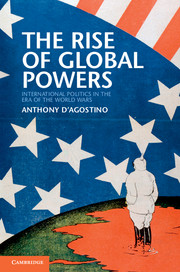Book contents
- Frontmatter
- Contents
- Maps
- Acknowledgements
- Introduction
- 1 The great powers at the dawn of world politics
- 2 Global origins of World War I: from the China scramble to the world crisis of 1904–1906
- 3 Global origins of World War I: a chain of revolutionary events across the world island
- 4 Balance and revolution, 1914–1918
- 5 A ragged peace, 1919
- 6 Scramble for Eurasia, 1919–1922
- 7 Drastic acts of unhappy powers, 1922–1923
- 8 Storms in the lull, 1924–1927
- 9 Politics and economics of the great slump, 1928–1933
- 10 A vogue for national economy
- 11 Mussolini’s moment, 1933–1935
- 12 The global civil war, 1936–1937
- 13 Last years of peace, 1937–1939
- 14 The European war, 1939–1941
- 15 The world war
- 16 Balance and hegemony
- Maps
- Notes
- Index
1 - The great powers at the dawn of world politics
Published online by Cambridge University Press: 05 June 2012
- Frontmatter
- Contents
- Maps
- Acknowledgements
- Introduction
- 1 The great powers at the dawn of world politics
- 2 Global origins of World War I: from the China scramble to the world crisis of 1904–1906
- 3 Global origins of World War I: a chain of revolutionary events across the world island
- 4 Balance and revolution, 1914–1918
- 5 A ragged peace, 1919
- 6 Scramble for Eurasia, 1919–1922
- 7 Drastic acts of unhappy powers, 1922–1923
- 8 Storms in the lull, 1924–1927
- 9 Politics and economics of the great slump, 1928–1933
- 10 A vogue for national economy
- 11 Mussolini’s moment, 1933–1935
- 12 The global civil war, 1936–1937
- 13 Last years of peace, 1937–1939
- 14 The European war, 1939–1941
- 15 The world war
- 16 Balance and hegemony
- Maps
- Notes
- Index
Summary
The history of the balance of power is the story of a struggle among great territorial states, a story that is for the most part a narrative of contention among Europeans. At any rate, that was the way it must have seemed at the turn of the twentieth century. It was all about to change profoundly. Today Europe is struggling to maintain its unity under a unified currency. It is a world “player” but not at all in the sense of projecting power and keeping formidable armies and navies. Yet, in 1900 Europe certainly appeared to be at an apogee in world history. This “little cape off the Asian mainland,” as the poet Paul Valéry called it, ruled the world as it had never been ruled. European states had just divided Africa into colonial spheres of influence. China appeared to be next. The six continents of the world were coming to understand their fates to be interdependent and at the same time tangled up with the actions of the great powers and their distant possessions. Events in the Transvaal, or on the Shantung peninsula, on San Juan Hill in Cuba or Manila Bay, reverberated all over the globe. They seemed to have their source in Europe. The people of the earth numbered some 1.6 billion, about a quarter of them Europeans, with approximately half of the remainder, some 600 million, under some form of European tutelage. Looked at in another way, in 1800, in a world population of one billion, there had been roughly 200 million Europeans. By 1900, the world’s population had augmented by around 60 percent, while the European population had doubled. To Europeans it seemed that theirs was the population that was growing the fastest and was marked by destiny to inherit the earth.
They looked at the map and saw most of it controlled by Europeans, along with some vast “empty” lands ready to be settled by them in the future. These were still being charted by intrepid explorers and cartographers. Most of the celebrated discoveries had already been made by the Spekes and Burtons, the Stanleys and de Brazzas. But maps still showed white spots, the Congo and Amazon basins, the centers of Arabia and Central Asia, the peaks and plateaus of Tibet. Sir Arthur Evans was digging around on the grounds of the palace ruins at Knossos in Crete, which, he was to claim, had been built in 1900 BC. Sir Aurel Stein was looking into the Caves of a Thousand Buddhas in the remote western Chinese oasis of Dunhuang, with their stone temples, ancient paintings, and libraries buried beneath the sand. The French thought that the expedition of their explorers Ferdinand Foureau and Amédée-François Lamy from Algiers to the Congo should result naturally in the construction of a Trans-Saharan railway. If the Canadians and the Americans could build rail lines across the North American continent, and the Russians Siberia, and the Germans their Berlin-to-Baghdad Railway, surely this was feasible. The British themselves dreamed of a Cape-to-Cairo Railway and the Americans of a line from New York to Rio. The airplane, the motor car, and world politics were in a few decades to compel a change in these plans, but this was not for lack of energy and vision on the part of the white man. In 1900, it was impossible not to have great plans. Africa had been gathered under European political and military influence. The Germans were increasing their say in the affairs of the Ottoman Empire. Britain and Russia were sealing off the areas in Persia and Afghanistan regarded in London as the marches to India. There seemed to be no limit to the capacities of those presumed to be the natural governing races to extend their fields of activity.
- Type
- Chapter
- Information
- The Rise of Global PowersInternational Politics in the Era of the World Wars, pp. 8 - 34Publisher: Cambridge University PressPrint publication year: 2011



